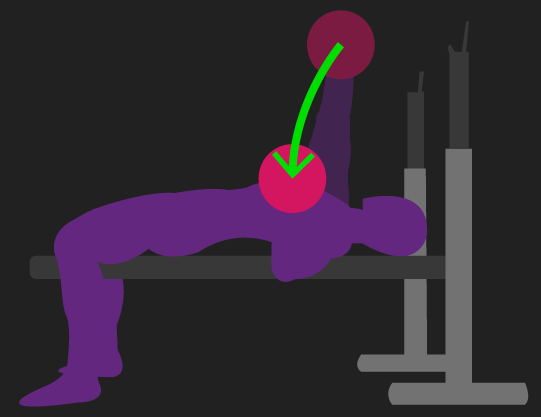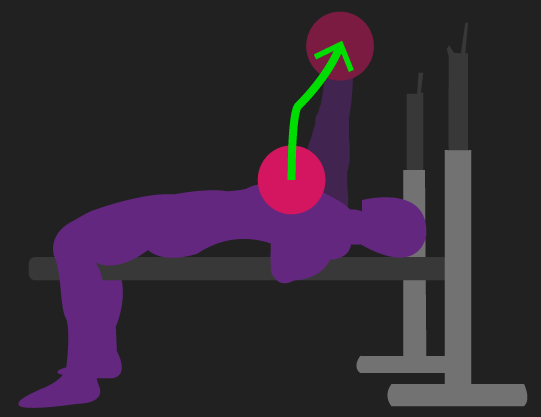
The barbell bench press is probably the most popular upper body exercise. In a previous article, we’ve detailed a fair amount of research depicting how effective the barbell bench press is at inducing chest hypertrophy.
Aside from chest hypertrophy, many individuals also seek to maximize their bench press strength.
One important component of maximizing bench press strength is optimizing your bar path.
We can simply split the bar path in the bench press (and pretty much any other exercise) into a lowering and lifting phase.
In this article, we’ll be using some interesting research carried out by McLaughlin to determine how an ideal bench press bar path should roughly look.
Before starting, I’d be remiss to mention that if it was not for an article on bar path by strongerbyscience.com, I’d never have come across this research. They have a great and detailed article describing the research by McLaughlin, I highly recommend anyone checks it out.
Lowering Phase
Interestingly, based on McLaughlin’s research, novice and elite lifters appear to share a comparable lowering phase: a slightly curved diagonal line going from above the shoulders to the mid to lower chest region.

Now, some of you may be wondering about a completely straight lowering bar path.
This bar path is thought to be potentially dangerous. Some research indicates that repetitive movements at 90 degrees of shoulder abduction (the position the shoulders would be in at the end of a straight lowering bar path) could increase acute and chronic shoulder injury risk.

Additionally, for individuals who care most about bench press strength, the lowering bar path shown in McLaughlin’s research reduces the range of motion to a degree, something that is beneficial for lifting heavier loads.
Lifting Phase
This is where it gets interesting.
In McLaughlin’s research, the novice lifters lifted the bar straight up initially, and then back over the shoulders.

Opposingly, elite lifters pushed the bar back initially, and then straight up.

The elite lifters bar path appears to be more efficient, likely because it makes the exercise easier on the shoulders.
Let me explain.
During the bench press, your shoulders have to work the hardest when the barbell is away from the line of your shoulders.
For instance, see the two images below. The first one depicts the barbell being in line with the shoulders, this position is fairly easy to hold. Conversely, the second picture depicts the barbell away from the line of the shoulders, this position is harder to hold, as your shoulders are now having to work harder.

These principles remain in play during the motions of a bench press. At the end of the lowering phase (assuming the normal lowering bar path), as the bar is farthest away from the line of your shoulders, the shoulders are going to be working their hardest.

By using the elite lifters lifting bar path (pushing the bar back initially), you quickly reduce the distance between the barbell and your shoulder line, thereby quickly reducing the demands placed on your shoulders, making the completion of the lifting phase easier.
Contrast this to the novice lifters, by lifting straight up initially, the barbell remains the farthest distance away from the shoulder line, meaning the shoulders have to continue working their hardest.
Before moving on, if you’re curious about creating an effective training program for muscle hypertrophy, our high quality partner Alpha Progression can help. It can generate a highly effective program for you, track your workouts live with in-built progression recommendations, provide graphs displaying your long term progress, and it has a massive exercise database with more than 550 exercises.
Click HERE (the link opens in a new tab) to get a free 2 week trial of the apps features. If you like it and go beyond, the link also gives you 20% off a subscription!
We never promote trash at the House of Hypertrophy, so rest assured the app is high quality. The reviews speak to this, 4.8 starts (based on more than 7,000 reviews) on Google play, and 4.9 stars in Apple’s store (based on nearly 400 ratings).
Bar Path During Submaximal Repetitions
I should mention that the ideal lifting bar path detailed above is probably only practical during repetitions that are quite hard, either because the weight is near or at your one-rep max, or because you are nearing failure with a submaximal load.
Research by Wilson et al. demonstrates this. They found that when elite powerlifters performed a one-rep max, the lowering and lifting bar paths were executed as described in McLaughlin’s research.
However, when performing a repetition with an 81% one-rep max load, although the lowering phase was more or less the same, the lifting phase was not. Rather, the lifting phase looked pretty much like the reverse of the lowering phase.
This makes sense. With loads that are easy to move (submaximal loads), it’s pretty difficult to push the bar back initally and then up, simply because the bar feels too light. Consequently, it’s much simpler to just reverse the lowering phase motion.
But with hard repetitions where your muscles are exerting high forces and the barbell is moving slowly, it’s alot easier to focus on pushing the bar back initially and then up.
Remember to feel free to check out the Alpha Progression App if you’re interested. Also feel free to check out our free bench press e-book below.

